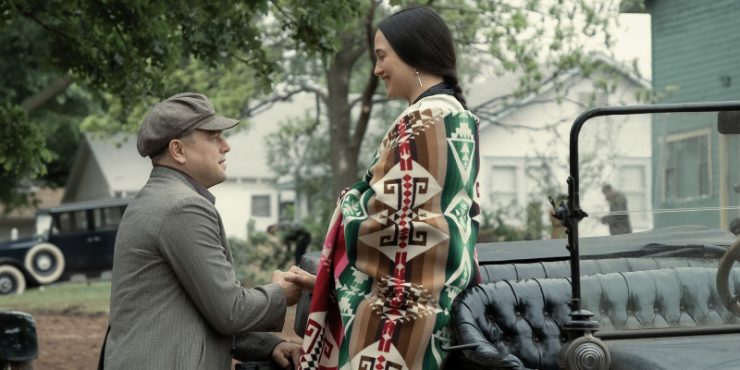David Grann’s 2017 book Killers of the Flower Moon is a chilling piece of true crime literature. A good amount of it is a thrilling FBI procedural, but the emotional core of it is Molly Burkhart and her husband Ernest. Their marriage is the story’s central contradiction. She is native Osage and he’s white. Her family and her people are dying in numerous ways, suspicious crime scenes go un-investigated. His family and his people are the most powerful in the county, holding financial and political influence over everyone. In adapting the book, Scorsese has chosen Molly and Ernest’s love story as the central focus, not because it’s romantic, but particularly because it isn’t. The insidiousness of American racism – whether it be against African slaves or American Indians – is such that it can even puncture enduring love.
Scorsese wrote the script with veteran writer Eric Roth (Forrest Gump, Munich). By focusing the story away from the FBI and onto Molly and Ernest, Scorsese gives himself the opportunity to make the film version more about the Osage people. It’s a noble creative decision, and one that does give Flower Moon some fantastic pieces of drama, but it also asks a lot from the audience. At three hours and twenty-six minutes, the movie does feel genuinely confused about point-of-view, and there is a tension between the characters that Scorsese empathizes with and the characters that the camera is most fixated on. This is a movie that aspires to stare deep into the heart of America’s original sin, but it’s a mixed bag of execution, with stunning set pieces placed alongside ponderous sequences
This is the first time that Scorsese has worked with both Leonardo DiCaprio and Robert De Niro, the two actors who have come to define the legendary director’s career. If De Niro is the collaborator who worked in creating the Scorsese mythos, DiCaprio is the one that helped cement it into emeritus status. DiCaprio plays Ernest Burkhart, a World War I veteran who saw little action before returning home to Oklahoma to live and work with his uncle, Bill Hale (De Niro). Everyone calls Bill “king”, and it’s a fitting title; he’s the most influential man in all of Osage county. Osage is Indian territory, but Bill has made well in the region, bringing the Osage into the Twentieth Century with roads and schools – he’s brought them civilization. Bill is beloved among the natives, and he wants Ernest to join in the prosperity.
The Osage are an anomaly among Native American tribes in that they have money. Forced by white men to live in the most arid lands of Oklahoma, it just so happened that they were on top of a massive oil reserve. With ownership of the oil as well as the headrights on the land it came up from, the Osage became some of the richest people in the world, often displaying it with shiny silk clothing and gleaming jewelry. Not all Osage were immodest in their wealth. There’s Molly Kyle (Lily Gladstone) who lives quietly with her mother (Tantoo Cardinal) and her three sisters. When Molly gets into a cab driven by Ernest, he lays on the charm thick. His uncle has subtly explained the benefits of marrying into the Osage ranks and having children with them – a good way to get the oil money back into the pockets of the white citizens.
That Ernest sincerely loves Molly doesn’t appear to create a hitch in Bill’s longterm plans. For Bill, loyalty is a one way street – full commitment to him is expected but he is not beyond betrayal if it serves his own ends. Ernest, a profoundly weak-willed man, lives entirely under his uncle’s thumb, and his devotion to Bill often puts him at direct odds with his responsibility to Molly and their children. Osage bodies begin to accumulate, some appear to die methodically of “wasting disease”, while others are found shot. Police do little, making dubious claims of suicide or appealing to the Osage’s “inherently sickly” nature. When Molly’s sister, Anna (Cara Jade Myers), is found shot, it becomes clear that someone is systematically murdering Osage in an effort to gain control of their oil money.
Where Grann’s book unfolds like a murder mystery, Scorsese’s film is instead a steady steep into the darkness of unconscionable acts. The choice kills suspense while heightening drama, as we’re made to fathom what men are capable of in the name of greed. Jesse Plemons plays Tom White, a former Texas Ranger now working at the advent of the FBI. White is probably the main character of the book, but in the film he doesn’t arrive until well within the third hour. The movie’s central conflict is how Ernest reconciles his love for Molly while enabling his uncle’s ruthless quest for power, and his major delusion that the two can coexist. Delusion is a major problem for Bill Hale as well, as he seems incapable of viewing himself as anything other than a beloved savior for the Osage while undermining them at every turn. Scorsese is speaking to the persistent, insidious nature of American racism, and how it reverberates even through its liberalism.
Protagonists with the power to reimagine the context of their terrible behavior is nothing new for Scorsese. He does this better than any filmmaker who ever lived, but Flower Moon seems to be in active conflict with itself. It’s understandable reverence for the Osage sits uncomfortably next to its preoccupation with Ernest and Bill. In trying to hold two ideas in its head, it ultimately holds neither. This is apparent most in the performances of Gladstone and DiCaprio. Gladstone, an actor of remarkable grace and subtle power, is probably the best performance in the film, but through narrative necessity, she’s given very little to do. DiCaprio at times is doing some of the best acting of his career, but Ernest is a simple character stretched by a complex scenario, and it does the actor no favors to have him sit on that razor’s edge for 206 minutes. And frankly, there are moments where his hambone delivery feels like he’s doing a regional interpretation of Sling Blade.
It’s telling that this movie feels most at home with Robert De Niro’s Bill Hale, the movie’s most unequivocal villain. De Niro is incredible in the part, technically flawless and effectively scary. He’s unburdened by the emotional nuance that DiCaprio and Gladstone are asked to wade through. When you read Grann’s book, it is truly fascinating to comprehend the theoretical home life of Molly and Ernest, the way it navigated its foundational implausibility. But this film does not deal in theoreticals, and the literalness of cinema pushes this concept further than can be sustained. Killers of the Flower Moon is an occasionally very good film, especially when it leans into the cultural specifics of the Osage and the ways they persevere against oppression and subjugation, but it doesn’t always mix with its parsed take on evil – that while it costs the victims their lives, it costs the perpetrators their soul.
The movie’s final scene is a very Scorsese-ian flourish that fully illustrates the flippancy with which American audiences eagerly consume and casually dispose of its true crime stories. Its one of the few moments of Flower Moon where its themes seem properly tiered, that the outrage is appropriately front-facing. Allusions to the Tulsa massacre appear a handful of times in the background, drawing a direct line between the two events, different shades of the same racism that has come to define American culture. Scorsese is earnestly asking white audiences to sit in their own complicity, but that request feels muddled next to the humanization of Ernest. Of course, that humanization only refines his monstrousness, and perhaps that’s the real point: the most evil people in the world are still people after all.
Directed by Martin Scorsese










